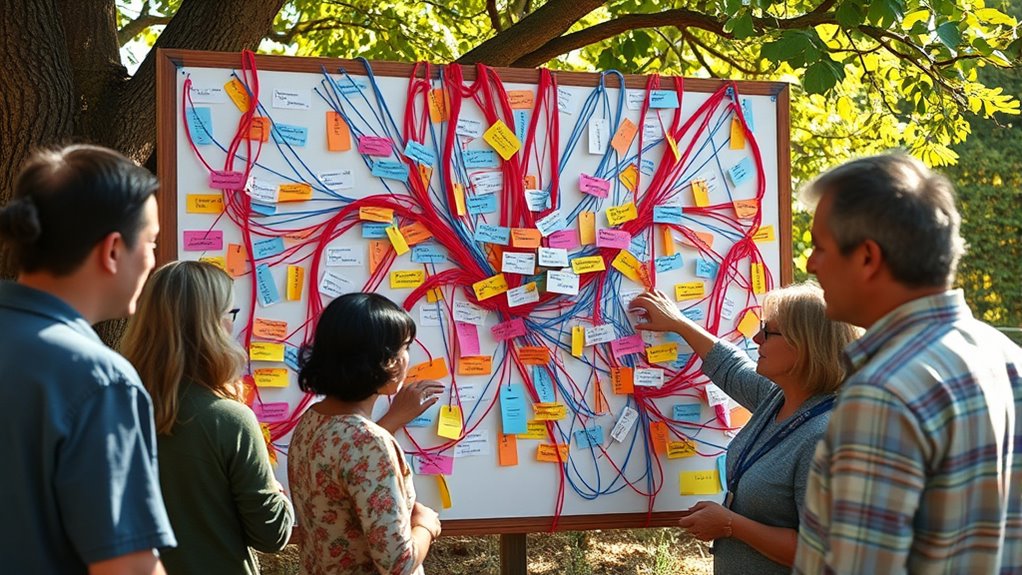To establish an emergency contact tree for your community, start by creating a clear, organized structure that defines who communicates with whom and their roles. Gather current contact details, including multiple channels like phone, email, or messaging apps, and assign backup contacts for resilience. Conduct regular drills to test protocols and update your lists often. A well-designed contact tree promotes quick responses and builds trust—keep exploring for detailed steps to guarantee your community’s safety.
Key Takeaways
- Define clear roles and communication flow within the contact tree to ensure quick information dissemination.
- Maintain accurate, updated contact lists using accessible, multi-channel databases for redundancy.
- Establish protocols for message sharing, including safety updates and resource needs, to prevent misinformation.
- Assign volunteers based on skills and availability, providing training and regular drills for preparedness.
- Plan for backup contacts and conduct periodic reviews to strengthen resilience and community trust during emergencies.

Emergency contact trees are organized networks that help you quickly reach the right people during a crisis. When an emergency strikes, time is of the essence, and having a clear, well-structured contact tree ensures that essential information spreads rapidly and efficiently. The foundation of an effective contact tree relies on establishing solid communication protocols. These protocols specify who communicates with whom, how messages are relayed, and what information needs to be shared at each step. By defining these rules beforehand, you prevent confusion and ensure everyone stays on the same page during an emergency. It’s imperative to determine primary and backup contacts within each group, so if someone is unavailable, others can step in without delay. Clear communication protocols also include instructions on the type of information to share, whether it’s safety updates, instructions for evacuation, or resource needs. This consistency helps avoid misinformation and keeps the community coordinated. Additionally, implementing privacy and data protection measures ensures that sensitive information remains secure within your contact network.
Volunteer coordination plays a critical role in setting up and managing your contact tree. Volunteers are often the backbone of community response efforts, and organizing them effectively ensures your network functions smoothly. When establishing your contact tree, assign specific roles to volunteers based on their skills, availability, and proximity. Make sure each volunteer understands their responsibilities, including whom they need to contact and how to relay information. Regular training and updates help reinforce these roles and protocols, so everyone remains prepared. Creating a volunteer roster with contact details, preferred communication methods, and backup contacts ensures the system remains resilient. As part of volunteer coordination, you should also plan for regular drills or practice runs. These exercises reveal gaps in your communication protocols and help volunteers become comfortable with their roles. Clear instructions and ongoing support foster confidence and ensure that, when a real emergency occurs, your contact tree functions seamlessly.
In addition to setting up the structure, you should keep your contact list current. People’s contact details change, and volunteers may move or become unavailable. Maintaining an updated, accessible database of contacts ensures message delivery isn’t delayed. Using multiple communication channels—such as phone trees, emails, and messaging apps—can also improve reach and redundancy. As you fine-tune your contact tree, remember that simplicity and clarity are key. The goal is to make sure everyone knows exactly what to do, who to contact, and how to do it efficiently. With well-defined communication protocols and strong volunteer coordination, your community’s emergency contact tree becomes a dependable tool that enhances safety, fosters trust, and promotes swift action in times of need.
Frequently Asked Questions
How Often Should Emergency Contact Trees Be Reviewed or Updated?
You should review and update your emergency contact tree at least twice a year to guarantee accuracy. Follow a regular maintenance schedule, such as every six months, and incorporate feedback collection from community members to identify any changes or issues. This proactive approach keeps your contact tree reliable, so you can respond quickly during emergencies, knowing all contacts are current and correct.
What Technology Tools Can Help Manage and Coordinate Contact Trees?
Think of managing contact trees like steering a ship through stormy seas—you need reliable navigation tools. Mobile apps and cloud platforms act as your GPS, keeping your contact information organized and accessible in real time. These tools allow you to quickly update contacts, send alerts, and coordinate efforts seamlessly. Using technology, you guarantee your community stays connected and responsive, no matter how rough the waters get.
How Do We Ensure All Community Members Are Informed and Participate?
You can guarantee all community members are informed and participate by actively engaging in community outreach, explaining the importance of the contact tree. Use participation incentives like recognition or small rewards to motivate involvement. Regularly update everyone through multiple channels, such as social media, flyers, and meetings. Encourage feedback and questions, creating an inclusive environment. This approach boosts participation and ensures everyone stays informed during emergencies.
What Strategies Address Language Barriers Within the Contact Tree?
Think of your community’s contact tree as a tapestry woven with many threads. To address language barriers, you should include multilingual materials that speak to diverse residents, ensuring everyone understands. Additionally, offering interpreter services helps bridge communication gaps, making sure no one is left out. These strategies create a more inclusive network, fostering trust and quick action during emergencies, so everyone stays connected and informed when it matters most.
How Can We Integrate Emergency Contact Trees With Local Emergency Services?
To integrate emergency contact trees with local emergency services, you should develop clear communication protocols that outline how information flows between your community and responders. Coordinate response teams by sharing contact details and establishing regular updates. This guarantees everyone stays informed and prepared. By building strong connections and aligning procedures, you enable quick, effective responses during emergencies, ultimately enhancing safety and collaboration between your community and emergency services.
Conclusion
By setting up emergency contact trees, you create a network of trust, a web of support, and a chain of safety. These trees confirm everyone stays informed, everyone stays prepared, and everyone stays connected. With clear roles, open communication, and shared responsibility, your community becomes stronger, safer, and more resilient. Together, you build a safety net that catches everyone in times of need, turning individual efforts into collective security.








